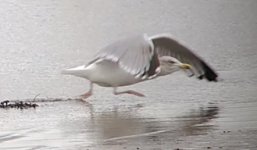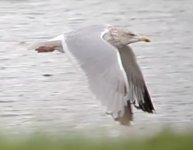martyrynin
Guest

Hey,
I saw this gull this morning, Ireland - North coast.
I'm basically certain that it is a European Herring gull, but I was wondering what the best way to solidify that is.
Is the underside of p10 being solid black the most diagnostic feature here?
There's no black on p5 which is really bad for AHG, but can still happen, in the same way that a European Herring gull can have an all black p9!
So I have identified the bird as European herring gull, I'm just wondering what is the best way to definitively (or close to certain) rule out AHG from these photos.
Thanks!
I saw this gull this morning, Ireland - North coast.
I'm basically certain that it is a European Herring gull, but I was wondering what the best way to solidify that is.
Is the underside of p10 being solid black the most diagnostic feature here?
There's no black on p5 which is really bad for AHG, but can still happen, in the same way that a European Herring gull can have an all black p9!
So I have identified the bird as European herring gull, I'm just wondering what is the best way to definitively (or close to certain) rule out AHG from these photos.
Thanks!
Attachments
-
 IMG_20250113_151948.jpg8.9 KB · Views: 10
IMG_20250113_151948.jpg8.9 KB · Views: 10 -
 IMG_20250113_152436.jpg21.8 KB · Views: 11
IMG_20250113_152436.jpg21.8 KB · Views: 11 -
 IMG_20250113_214932.jpg20.9 KB · Views: 10
IMG_20250113_214932.jpg20.9 KB · Views: 10 -
 IMG_20250113_195235.jpg20.8 KB · Views: 8
IMG_20250113_195235.jpg20.8 KB · Views: 8 -
 IMG_20250113_195038.jpg61.3 KB · Views: 10
IMG_20250113_195038.jpg61.3 KB · Views: 10 -
 IMG_20250113_195149.jpg28.8 KB · Views: 9
IMG_20250113_195149.jpg28.8 KB · Views: 9 -
 IMG_20250113_194949.jpg15.8 KB · Views: 8
IMG_20250113_194949.jpg15.8 KB · Views: 8 -
 IMG_20250113_152512.jpg23.8 KB · Views: 8
IMG_20250113_152512.jpg23.8 KB · Views: 8 -
 IMG_20250113_152117.jpg22.6 KB · Views: 10
IMG_20250113_152117.jpg22.6 KB · Views: 10 -
 IMG_20250113_152241.jpg15.5 KB · Views: 10
IMG_20250113_152241.jpg15.5 KB · Views: 10 -
 IMG_20250113_152049.jpg17.5 KB · Views: 10
IMG_20250113_152049.jpg17.5 KB · Views: 10 -
 IMG_20250113_152010.jpg15.7 KB · Views: 8
IMG_20250113_152010.jpg15.7 KB · Views: 8






